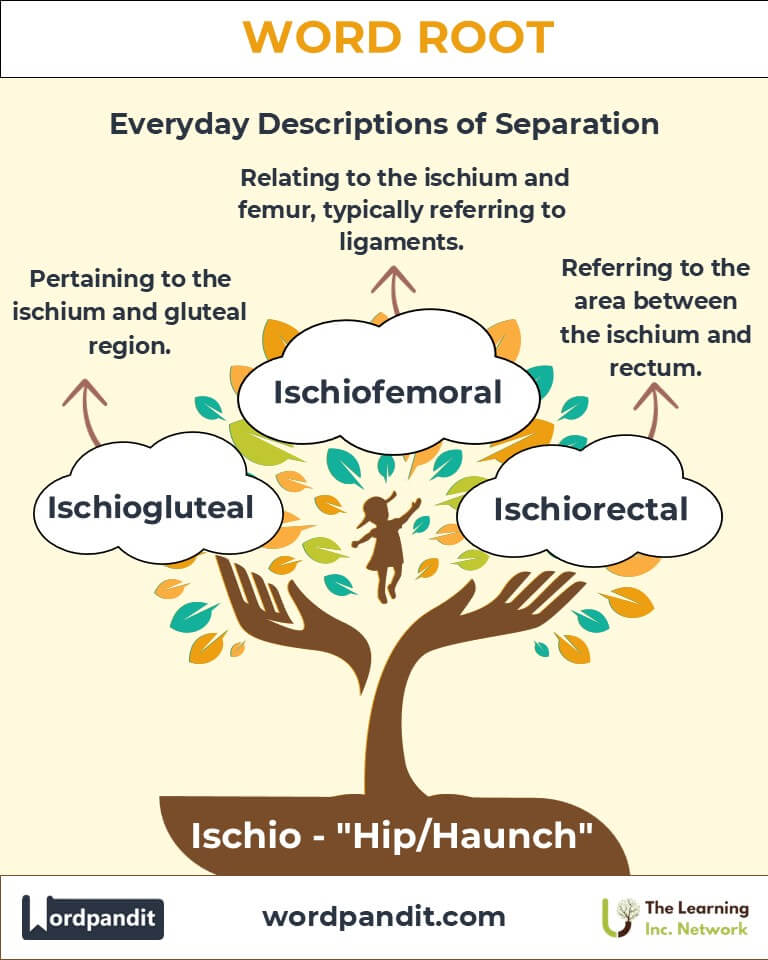Ischio: Anchoring the Body in Motion and Stability
Dive into the fascinating world of the root ischio, derived from the Greek word for "hip" or "haunch." From the foundational ischium in anatomy to the technical ischiatic in medical fields, this root forms the basis of terms central to understanding human locomotion and skeletal structure.

Table of Contents
- Introduction: The Core of Ischio
- Etymology and Historical Journey
- Mnemonic: Remembering Ischio with Ease
- Common Ischio-Related Terms
- Ischio Through Time
- Ischio in Specialized Fields
- Illustrative Story: Ischio in Action
- Cultural Significance of Ischio
- The Ischio Family Tree
- FAQs about the Ischio Word Root
- Test Your Knowledge: Ischio Mastery Quiz
- Conclusion: The Enduring Significance of Ischio
1. Introduction: The Core of Ischio
At the heart of human movement lies the ischium, a key component of the pelvic bone. Pronounced IS-kee-um, this anatomical term highlights the hip's role in supporting body weight and facilitating mobility. The root ischio, from Greek origins, connects to numerous medical and anatomical terms that describe the hip region's structure, function, and disorders. Its relevance spans disciplines, from orthopedics to physical therapy, underscoring its importance in understanding the human body's foundation.

2. Etymology and Historical Journey
The root ischio stems from the Greek word ischion, meaning "hip" or "haunch." Historically, the ischium was recognized as a crucial support structure, forming part of the pelvis that bears weight when sitting. Ancient anatomists highlighted its connection to the body's balance and stability, and its significance has only grown with advancements in medical science.
3. Mnemonic: Remembering Ischio with Ease
Picture a sturdy chair supporting a seated figure—the chair represents the ischium, the "seat" of stability in the pelvis.
Mnemonic Device: "The ischium is where you sit—it’s the hip’s anchor kit!"
4. Common Ischio-Related Terms
- Ischium (IS-kee-um): The curved bone forming the base of the pelvis.
Example: "The ischium supports much of the body’s weight while sitting." - Ischiatic (is-kee-AT-ik): Pertaining to the ischium, often describing related nerves or structures.
Example: "The ischiatic nerve, also known as the sciatic nerve, is the longest in the human body." - Ischiofemoral (is-kee-oh-FEM-or-uhl): Relating to the ischium and femur, typically referring to ligaments or connections.
Example: "The ischiofemoral ligament stabilizes the hip joint." - Ischial (IS-kee-uhl): Adjective form of ischium, describing features of this bone.
Example: "Ischial pain can result from prolonged sitting on hard surfaces." - Ischiopubic (is-kee-oh-PYOO-bik): Concerning the ischium and pubic bone, often referencing a bony junction.
Example: "The ischiopubic ramus is vital in pelvis stability."
5. Ischio Through Time
- Ancient Use: In early anatomy texts, the ischium was identified as the "seat bone," critical for posture and sitting.
- Modern Expansion: Terms like ischiatic and ischiofemoral evolved with medical advancements, describing more detailed relationships within the pelvis.
6. Ischio in Specialized Fields
- Orthopedics: The ischium is essential in diagnosing and treating hip fractures or conditions like ischial bursitis.
Example: Ischial injuries are common among athletes in sports requiring sudden hip movements. - Physical Therapy: Ischiatic nerve compression can lead to sciatica, a condition requiring targeted rehabilitation.
Example: Exercises focusing on the ischiopubic region improve mobility and reduce pain. - Biomechanics: The ischium plays a role in analyzing body weight distribution while sitting or walking.
7. Illustrative Story: Ischio in Action
Emma, a marathon runner, began experiencing discomfort near her lower pelvis. A visit to her orthopedist revealed inflammation of the ischiatic bursa—a cushioning sac near the ischium. Through physical therapy targeting the ischiofemoral ligaments and guided exercises, Emma regained her strength and returned to her passion for running, appreciating the ischium’s critical role in her movement.
8. Cultural Significance of Ischio
The ischium symbolizes support and stability in various traditions. In yoga and meditation, the ischial tuberosities (sitting bones) are grounding points during seated poses, emphasizing their spiritual and physical anchoring role.

9. The Ischio Family Tree
- Pub (Latin: "groin"):
- Pubic: Relating to the pubic bone.
- Fem (Latin: "thigh"):
- Femur: The thigh bone, connected to the ischium.
- Sacr (Latin: "sacred bone"):
- Sacrum: A triangular bone at the base of the spine, linking to the ischium.
FAQs About the Ischio Word Root
Q: What does "ischio" mean?
A: The root ischio derives from the Greek word ischion, meaning "hip" or "haunch." It primarily refers to the lower part of the pelvis (the ischium), which plays a critical role in supporting the body while sitting and facilitating movement.
Q: What is the ischium?
A: The ischium is one of the three major bones forming the pelvis. It is the curved bone located at the base of the pelvis, providing stability and bearing the body’s weight when seated.
Q: What is the ischiatic nerve?
A: The ischiatic nerve is another term for the sciatic nerve, the largest and longest nerve in the human body. It runs from the lower back, through the ischium, and down to the legs, controlling sensation and movement in the lower limbs.
Test Your Knowledge: Ischio Mastery Quiz
1. What does "ischio" refer to?
2. What is the primary function of the ischium?
3. What is the ischiatic nerve also called?
4. Which ligament connects the ischium and femur?
5. What condition is caused by prolonged sitting on hard surfaces?
12. Conclusion: The Enduring Significance of Ischio
The root ischio embodies the essence of support, balance, and motion. From its anatomical origins to its specialized applications, it serves as a cornerstone in understanding human movement. As we delve deeper into the ischio-related terms and their significance, we gain a profound appreciation for the structures that anchor and empower us. Explore the world of ischio—a testament to the marvels of our body’s design.












